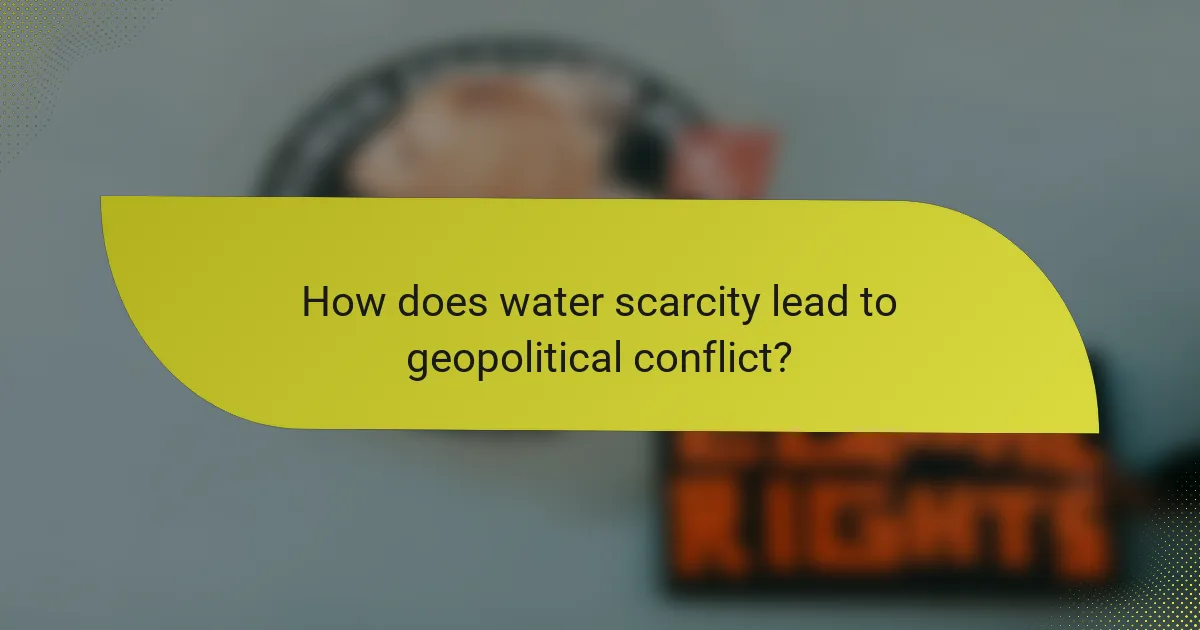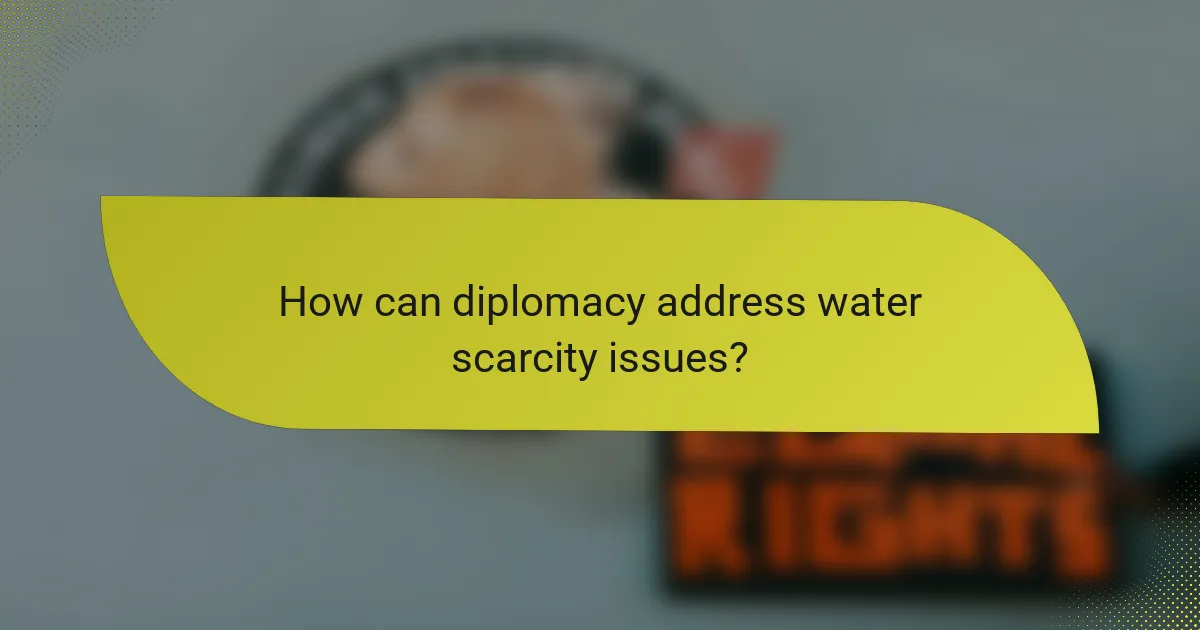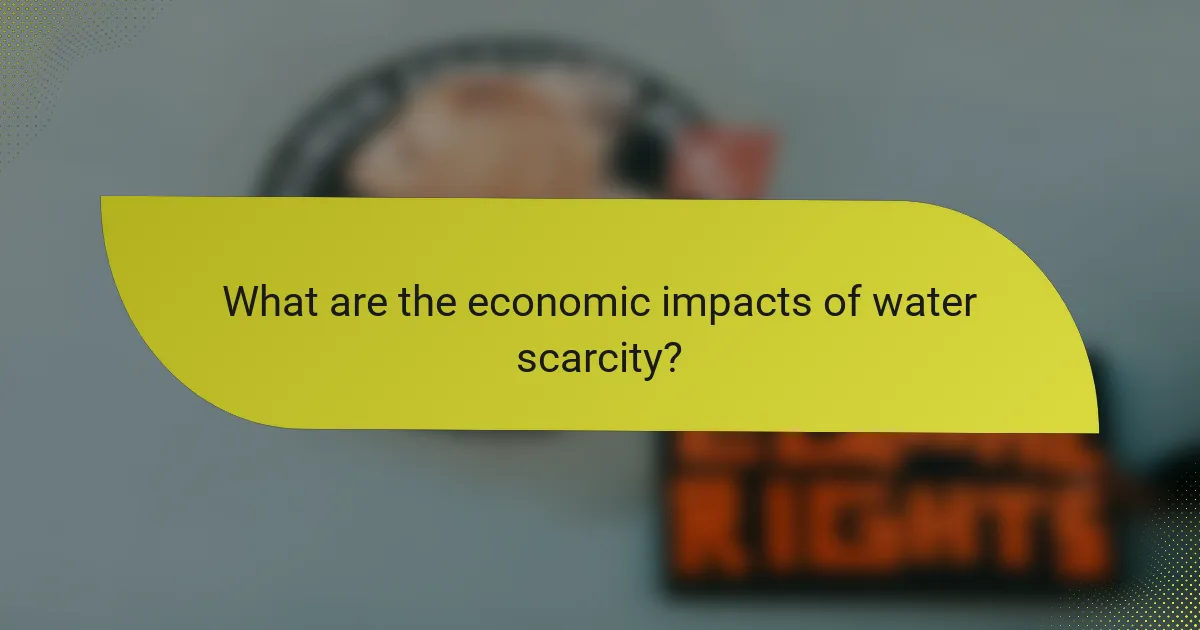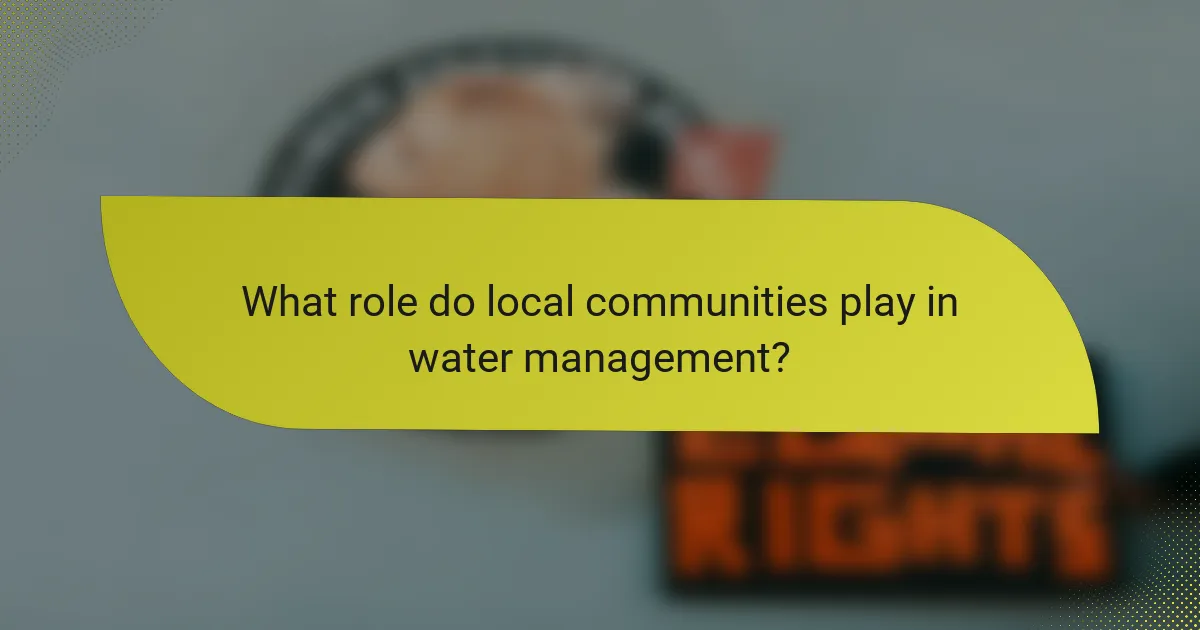Water scarcity poses significant challenges that can lead to geopolitical conflicts as nations vie for limited resources essential for survival and development. Effective resource management and innovative strategies are crucial for optimizing water use while ensuring sustainability and equity. Additionally, diplomacy plays a vital role in fostering cooperation among countries, enabling them to negotiate agreements that promote equitable distribution and sustainable management of shared water resources.

How does water scarcity lead to geopolitical conflict?
Water scarcity can trigger geopolitical conflict as nations compete for limited water resources, leading to tensions and disputes. This competition often escalates into conflicts, especially in regions where water is essential for agriculture, drinking, and industry.
Resource competition among nations
As freshwater resources dwindle, countries may engage in aggressive tactics to secure access to these vital supplies. This competition can manifest in various forms, including legal disputes over water rights, construction of dams, and military posturing along shared water bodies.
For instance, nations sharing river basins often negotiate treaties to manage water distribution, but these agreements can break down under pressure, leading to heightened tensions. Countries may also resort to unilateral actions that disregard existing agreements, further complicating relations.
Impact on regional stability
Water scarcity can destabilize entire regions by exacerbating existing tensions and creating new conflicts. When communities face water shortages, social unrest can increase, leading to protests and violence, which may spill over borders.
In regions like North Africa and the Middle East, water scarcity has been linked to civil unrest and migration, as people flee areas where water is no longer available. This movement can create additional pressures on neighboring countries, potentially igniting further conflict.
Case studies: Middle East tensions
The Middle East exemplifies how water scarcity can lead to geopolitical conflict. The Nile River, shared by several countries, has been a source of contention, particularly between Egypt and Ethiopia over dam projects that threaten water flow.
Similarly, the Tigris and Euphrates rivers, flowing through Turkey, Syria, and Iraq, have seen disputes over dam constructions and water allocation. These conflicts highlight the critical need for cooperative management of shared water resources to prevent escalation into violence.

What are the best practices for resource management?
Effective resource management involves strategies that optimize the use of water while ensuring sustainability and equity. Key practices include integrated approaches, technological advancements, and learning from successful policies in water-scarce regions.
Integrated water resource management
Integrated water resource management (IWRM) is a holistic approach that considers the interconnectedness of water resources, ecosystems, and human needs. It emphasizes stakeholder participation, balancing social, economic, and environmental objectives to achieve sustainable water use.
Key steps in IWRM include assessing water availability, identifying competing demands, and developing policies that promote efficient water allocation. Collaboration among government agencies, communities, and industries is crucial for effective implementation.
Technological innovations in water conservation
Technological innovations play a vital role in water conservation by enhancing efficiency and reducing waste. Techniques such as drip irrigation, rainwater harvesting, and advanced filtration systems can significantly lower water consumption in agriculture and urban settings.
Investing in smart water management systems, which utilize sensors and data analytics, can help monitor usage patterns and detect leaks. These technologies not only conserve water but also reduce operational costs for municipalities and businesses.
Examples from Israel’s water policies
Israel is a leading example of effective water resource management, employing a combination of innovative technologies and policies. The country has successfully implemented desalination plants, which provide a significant portion of its water supply, alongside extensive recycling of wastewater for agricultural use.
Additionally, Israel’s emphasis on public awareness and education about water conservation has fostered a culture of responsible usage. Policies promoting efficient irrigation practices and investment in research and development have positioned Israel as a model for other nations facing water scarcity challenges.

How can diplomacy address water scarcity issues?
Diplomacy can effectively address water scarcity issues by fostering cooperation among nations sharing water resources. Through negotiation and dialogue, countries can develop agreements that promote sustainable management and equitable distribution of water supplies.
International treaties and agreements
International treaties and agreements play a crucial role in managing transboundary water resources. These legal frameworks help establish guidelines for water usage, pollution control, and conflict resolution. Examples include the 1997 United Nations Convention on the Law of Non-Navigational Uses of International Watercourses, which provides a basis for cooperation among nations.
Countries can benefit from bilateral or multilateral agreements that outline specific water-sharing arrangements, ensuring that all parties have access to necessary resources while minimizing disputes. Regular reviews and updates to these treaties can adapt to changing environmental conditions and population needs.
Role of NGOs in conflict resolution
Non-governmental organizations (NGOs) play a vital role in mediating conflicts related to water scarcity. They often facilitate dialogue between conflicting parties, providing a neutral platform for discussion and negotiation. NGOs can also raise awareness about the importance of sustainable water management and the potential consequences of inaction.
By engaging local communities, NGOs help ensure that the voices of those most affected by water scarcity are heard in diplomatic discussions. Their involvement can lead to more equitable solutions that consider the needs of various stakeholders, including marginalized groups.
Successful diplomatic initiatives in Africa
Africa has seen several successful diplomatic initiatives aimed at addressing water scarcity. The Nile Basin Initiative, for instance, involves multiple countries working together to manage the Nile River’s resources sustainably. This collaborative approach has led to joint projects that improve water quality and accessibility for millions.
Another example is the Southern African Development Community (SADC), which promotes regional cooperation on water management. By sharing best practices and resources, member states can tackle water scarcity challenges collectively, enhancing resilience against climate change impacts.

What are the economic impacts of water scarcity?
Water scarcity significantly affects economies by limiting agricultural productivity, disrupting industries, and exacerbating regional inequalities. These impacts can lead to increased food prices, job losses, and heightened tensions within and between nations.
Effects on agriculture and food security
Agriculture is highly dependent on water availability, and scarcity can lead to reduced crop yields and livestock productivity. For instance, regions experiencing drought may see crop failures, which can drive food prices up significantly, affecting both local and global markets.
In areas where irrigation is essential, water shortages can force farmers to abandon fields, leading to food insecurity. This situation can result in increased reliance on food imports, further straining national economies and affecting trade balances.
Impact on industry and employment
Industries that rely heavily on water, such as manufacturing and energy production, face operational challenges during periods of scarcity. Companies may need to invest in expensive water-saving technologies or face production slowdowns, which can lead to job losses.
For example, in water-scarce regions, industries might relocate to areas with better water access, resulting in economic decline and unemployment in the original location. This shift can create a ripple effect, impacting local economies and communities.
Regional economic disparities
Water scarcity often exacerbates economic disparities between regions, particularly in countries where water resources are unevenly distributed. Wealthier areas may invest in advanced water management technologies, while poorer regions struggle to secure adequate supplies.
This disparity can lead to social unrest and migration as individuals seek better opportunities in water-rich areas. Governments may need to implement policies to address these inequalities, such as investing in infrastructure or providing financial support to vulnerable communities.

What frameworks exist for assessing water scarcity risks?
Several frameworks are in place to assess water scarcity risks, focusing on various factors such as availability, demand, and governance. These frameworks help countries and organizations understand their water resources and manage them effectively to mitigate conflicts and promote sustainable use.
UN Water Scarcity Framework
The UN Water Scarcity Framework aims to address global water challenges by providing guidelines and tools for sustainable water management. It emphasizes the need for integrated water resources management (IWRM), which considers social, economic, and environmental aspects of water use.
Key components of the framework include data collection, stakeholder engagement, and policy development. Countries are encouraged to adopt best practices and collaborate on transboundary water management to prevent conflicts and ensure equitable access to water resources.
World Bank water resource assessments
The World Bank conducts water resource assessments to evaluate the availability and quality of water in various regions. These assessments analyze factors such as climate variability, population growth, and economic development, providing insights into potential water scarcity risks.
By using a combination of satellite data, hydrological modeling, and field surveys, the World Bank offers actionable recommendations for improving water management. Countries can leverage these assessments to prioritize investments, enhance infrastructure, and implement policies that promote sustainable water use.

How does climate change exacerbate water scarcity?
Climate change significantly worsens water scarcity by altering weather patterns, increasing evaporation, and disrupting freshwater ecosystems. These changes lead to reduced water availability, impacting agriculture, drinking water supplies, and overall resource management.
Changing precipitation patterns
Climate change leads to shifting precipitation patterns, resulting in both increased rainfall in some areas and prolonged droughts in others. Regions that traditionally relied on consistent rainfall may experience severe shortages, while others may face flooding, leading to water management challenges.
For instance, areas in Southern Europe may see decreased rainfall during critical growing seasons, affecting crop yields and food security. Conversely, regions like parts of Southeast Asia may experience intense monsoons, overwhelming existing water infrastructure.
Increased evaporation rates
Higher temperatures associated with climate change increase evaporation rates from water bodies and soil, further reducing available freshwater. This phenomenon is particularly pronounced in arid and semi-arid regions, where water loss can exceed precipitation gains.
For example, lakes and reservoirs in the southwestern United States are shrinking due to elevated evaporation, exacerbating water scarcity for urban and agricultural use. Effective water management strategies must account for these losses to ensure sustainable usage.
Impact on freshwater ecosystems
Climate change disrupts freshwater ecosystems by altering habitats and affecting species that rely on stable water conditions. Changes in temperature and flow patterns can lead to the loss of biodiversity, impacting fish populations and other aquatic life.
In regions like the Great Lakes, warmer temperatures can lead to harmful algal blooms, which not only threaten aquatic life but also contaminate drinking water supplies. Protecting these ecosystems is crucial for maintaining water quality and availability for human use.

What role do local communities play in water management?
Local communities are crucial in water management as they often have the best understanding of their water resources and needs. Their involvement can lead to more effective and sustainable practices that reflect local conditions and cultural values.
Community Engagement in Water Governance
Community engagement in water governance involves local populations actively participating in decision-making processes regarding water use and management. This can include forming water user associations or participating in local councils that oversee water resources. Engaging communities helps ensure that policies are tailored to the specific needs and challenges faced by those who rely on the water supply.
Traditional Knowledge and Practices
Local communities often possess traditional knowledge about water management that has been passed down through generations. This knowledge can include sustainable practices such as rainwater harvesting, crop rotation, and the use of indigenous plants that require less water. Incorporating this wisdom into modern water management strategies can enhance resilience and sustainability.
Challenges in Community Participation
While local communities play a vital role in water management, several challenges can hinder their participation. These may include lack of access to information, limited resources, or external pressures from government or corporate interests. Addressing these challenges requires building trust, providing education, and ensuring that community voices are heard in policy discussions.
Examples of Successful Community-Led Initiatives
Successful community-led initiatives often showcase the effectiveness of local involvement in water management. For instance, in parts of India, community-managed water systems have improved access and efficiency, leading to better agricultural yields. Similarly, in various African nations, local groups have successfully implemented rainwater harvesting techniques that have significantly reduced water scarcity during dry seasons.
